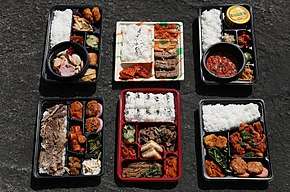Dosirak
Dosirak (도시락) in South Korea or kwakpap (곽밥) in North Korea refers to a packed meal. It usually consists of bap (Korean: 밥, cooked rice) and several banchan (side dishes).[1][2] The lunch boxes, also called dosirak or dosirak-tong (dosirak case), are typically plastic or thermo-steel containers with or without compartments or tiers.[3] Dosirak is often home-made, but is also sold in train stations and convenience stores.[4][5]

| Korean name (South Korea) | |
| Hangul | 도시락 |
|---|---|
| Revised Romanization | dosirak |
| McCune–Reischauer | tosirak |
| IPA | [to.ɕi.ɾak̚] |
| Korean name (North Korea) | |
| Chosŏn'gŭl | 곽밥 |
|---|---|
| Revised Romanization | gwakbap |
| McCune–Reischauer | kwakpap |
| IPA | [kwak̚.p͈ap̚] |
Varieties
Home-made dosirak is often packed in tiered lunch boxes that can separate bap (cooked rice) and banchan (side dishes).[6] The guk (soup) tier, if included, is usually kept warm by insulation.[7] Plastic or thermo-steel containers are most common, but combinations of wood and lacquer, ceramics and bamboo, as well as other materials, are also used.[8]
Yennal-dosirak (옛날 도시락; "old-time dosirak") consists of bap (rice), stir-fried kimchi, egg-washed and pan-fried sausages, fried eggs, and shredded gim (seaweed), typically packed in a rectangular lunchbox made of tinplate or German silver. It is shaken with the lid on, thereby mixing the ingredients, prior to eating.[3][7]
Gimbap-dosirak (김밥 도시락; "packed gimbap"), made with sliced gimbap (seaweed rolls), is often packed for picnics.[9]
Gallery
.jpg) Home-made dosirak
Home-made dosirak Yennal-dosirak (old-time dosirak)
Yennal-dosirak (old-time dosirak) Gimbap-dosirak
Gimbap-dosirak Dosirak sold in convenience stores
Dosirak sold in convenience stores Simple dosirak in a plastic container
Simple dosirak in a plastic container Thermal dosirak case
Thermal dosirak case
See also
- Bento
- Lunch box
- Packed lunch
- Tiffin
References
- "dosirak" 도시락. Standard Korean Language Dictionary (in Korean). National Institute of Korean Language. Retrieved 29 March 2017.
- "gwakbap" 곽밥. Standard Korean Language Dictionary (in Korean). National Institute of Korean Language. Retrieved 29 March 2017.
- "What the world eats for lunch". The Daily Meal. 24 September 2012. Retrieved 12 May 2017 – via Fox News.
- Hong, Ji-yeon (17 February 2016). "Local specialties take train travel to a new level". Korea JoongAng Daily. Retrieved 12 May 2017.
- Park, Han-na (15 October 2015). "Convenience stores vie for lunch box market". The Korea Herald. Retrieved 12 May 2017.
- Frizzell, Nell (24 July 2014). "Store-Bought Lunch Is Stupid and Wasteful". Munchies. VICE. Retrieved 12 May 2017.
- Williams, Maxwell (30 March 2017). "5 Best Lunches In the World". GOOD magazine. Retrieved 12 May 2017.
- Kim, Hyung-eun (2 May 2017). "Korean dining on view in London : Craft Week showcases fine objects used in eating and drinking". Korea JoongAng Daily. Retrieved 12 May 2017.
- Kayal, Michele (3 July 2012). "Thinking Outside The Bento Box". NPR. Retrieved 12 May 2017.